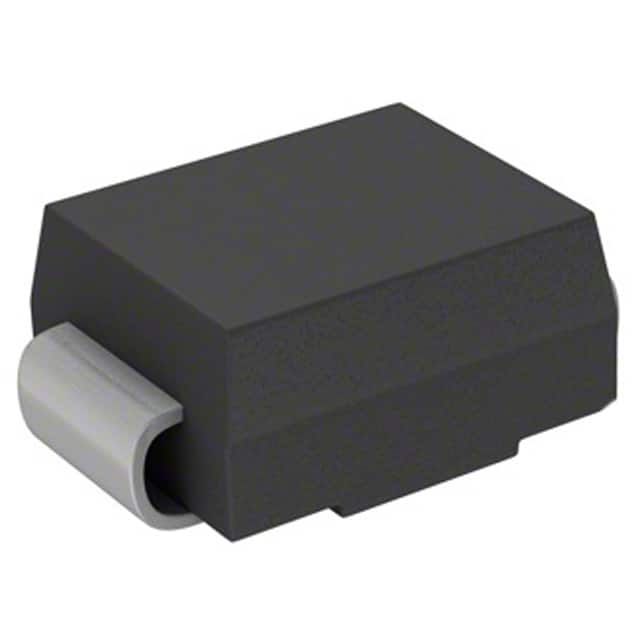Consulte las especificaciones para obtener detalles del producto.

ES2C-13 Product Overview
Introduction
The ES2C-13 belongs to the category of electronic components and is widely used in various electronic devices. This product possesses unique characteristics and comes in a specific package, making it essential for many applications.
Basic Information Overview
- Category: Electronic Components
- Use: ES2C-13 is used as a diode for rectification and switching purposes in electronic circuits.
- Characteristics: It exhibits low forward voltage drop, high current capability, and fast switching speed.
- Package: The ES2C-13 is typically packaged in a small, surface-mount package for easy integration into circuit boards.
- Essence: This diode serves as a crucial component in ensuring proper flow and regulation of electrical currents within electronic devices.
- Packaging/Quantity: It is commonly available in reels containing a specific quantity per reel.
Specifications
The ES2C-13 diode has the following specifications: - Forward Voltage Drop: 0.45V - Reverse Voltage: 100V - Average Rectified Current: 2A - Maximum Surge Current: 50A - Operating Temperature Range: -55°C to +150°C
Detailed Pin Configuration
The ES2C-13 diode features a standard SOD-123 package with two pins. The pin configuration is as follows: 1. Anode (A) 2. Cathode (K)
Functional Features
- Fast Switching Speed: Enables quick response in electronic circuits.
- Low Forward Voltage Drop: Minimizes power loss and heat generation.
- High Current Capability: Suitable for handling moderate to high current levels.
Advantages and Disadvantages
Advantages
- Efficient power management
- Compact size for space-constrained designs
- Reliable performance in various operating conditions
Disadvantages
- Limited reverse voltage tolerance compared to other diodes
- Sensitive to overvoltage conditions
Working Principles
The ES2C-13 operates based on the principles of semiconductor physics, utilizing its P-N junction to allow current flow in one direction while blocking it in the reverse direction. This enables it to function effectively in rectification and switching applications.
Detailed Application Field Plans
The ES2C-13 diode finds extensive use in the following application fields: - Power supplies - Voltage regulators - Switching circuits - LED lighting - Automotive electronics
Detailed and Complete Alternative Models
Several alternative models can serve as substitutes for the ES2C-13 diode, including: - 1N4148 - 1N4001 - 1N5819 - BAT54S
In conclusion, the ES2C-13 diode offers valuable functionality in electronic circuits, providing efficient rectification and switching capabilities. Its compact size and reliable performance make it a preferred choice for various applications across different industries.
Word Count: 387
Enumere 10 preguntas y respuestas comunes relacionadas con la aplicación de ES2C-13 en soluciones técnicas
What is ES2C-13?
- ES2C-13 is a type of electronic component, specifically a diode bridge rectifier, commonly used in power supply circuits to convert alternating current (AC) to direct current (DC).
What are the key specifications of ES2C-13?
- The ES2C-13 typically has a maximum average forward rectified current of 2A, a maximum repetitive peak reverse voltage of 200V, and a forward voltage drop of around 0.85V.
How is ES2C-13 used in technical solutions?
- ES2C-13 is often used in various technical solutions such as power supplies, battery chargers, and motor drives to convert AC power to DC power for electronic devices.
What are the typical applications of ES2C-13?
- Typical applications of ES2C-13 include LED lighting, consumer electronics, industrial automation, and automotive systems where AC to DC conversion is required.
What are the advantages of using ES2C-13 in technical solutions?
- ES2C-13 offers low forward voltage drop, high current capability, and compact size, making it suitable for space-constrained applications with moderate power requirements.
Are there any limitations or considerations when using ES2C-13?
- It's important to consider the maximum current and voltage ratings of ES2C-13 to ensure it can handle the specific requirements of the application. Thermal management may also be necessary to prevent overheating.
Can ES2C-13 be used in high-frequency applications?
- ES2C-13 is generally not recommended for high-frequency applications due to its recovery time and junction capacitance characteristics.
How does ES2C-13 compare to other diode bridge rectifiers?
- Compared to other diode bridge rectifiers, ES2C-13 may offer lower forward voltage drop and higher current capability, but it's essential to evaluate specific datasheets for accurate comparisons.
What are the typical failure modes of ES2C-13?
- Common failure modes of ES2C-13 include overcurrent damage, thermal stress, and voltage spikes, so proper protection and circuit design are crucial for reliable operation.
Where can ES2C-13 be sourced and purchased?
- ES2C-13 can be sourced from electronic component distributors, online retailers, and manufacturers' authorized distributors. It's important to ensure the authenticity and quality of the components when purchasing.

